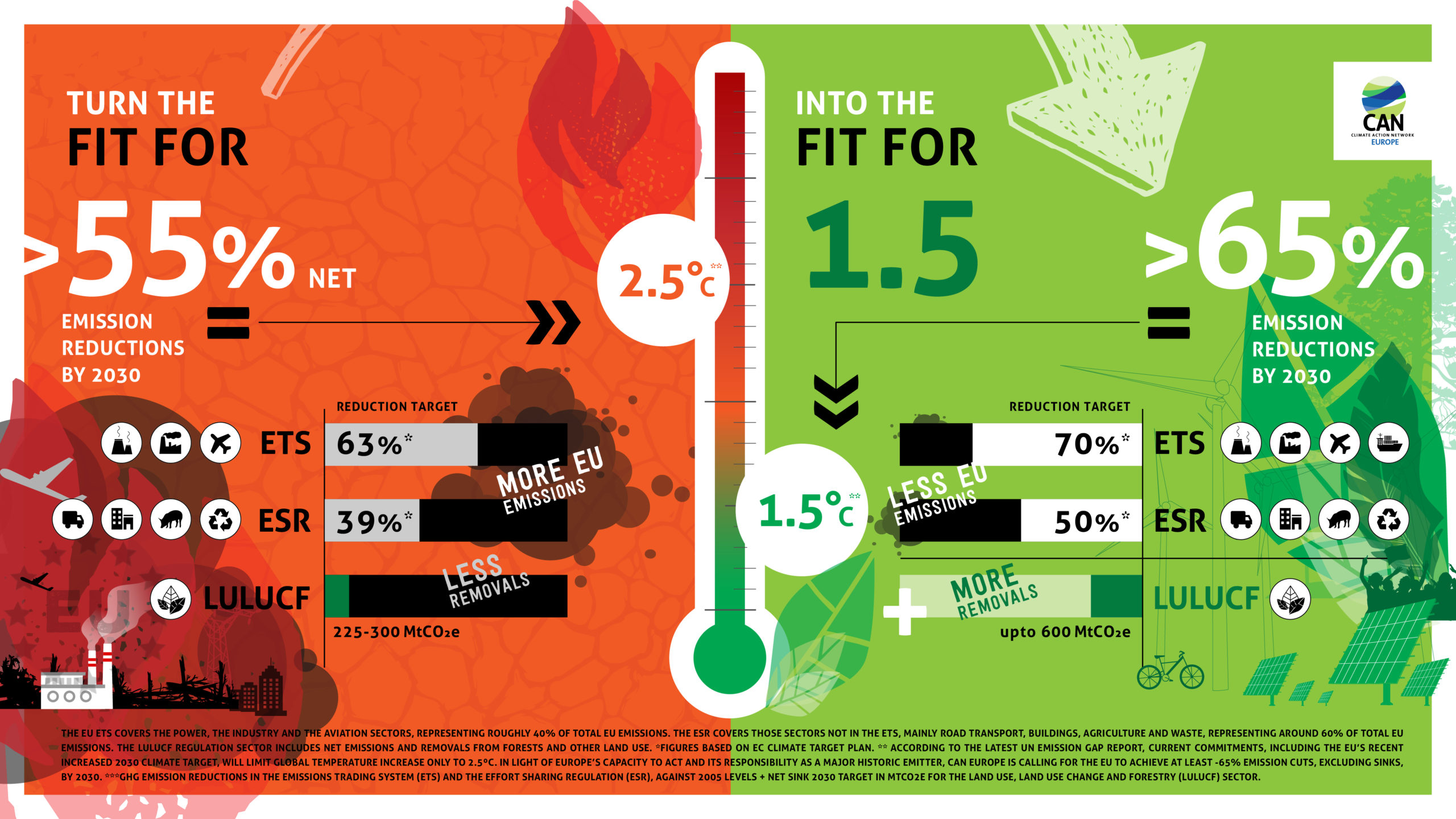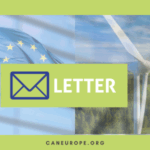MEDIA BRIEFING
-
In December 2020, the prime ministers and presidents of the European Union agreed to increase the EU’s 2030 climate target from at least 40% to at least 55% (net) emission cuts (both compared to 1990).
-
On July 14, the European Commission is expected to launch its ‘Fit For 55’ legislative package. This is a basket of a dozen policy proposals that aim to align the EU’s core climate and energy legislation with the new target.
-
As CAN Europe, we welcome the EU’s enhanced target. This has been a step in the right direction, yet it is still not enough for the EU to comply with its commitment under the Paris Agreement and limit temperature rise to 1.5°C.
-
With the launch of the ‘Fit For 55’ legislative package, the time is right to look into how to overshoot the EU’s current climate target and ensure we contribute to limiting temperature rise to 1.5°C.
-
As a rich economy, as well as a major historic emitter, the EU should strive for emission reductions of at least 65% by 2030. Only such a substantial cut will represent the EU’s fair contribution to achieving the Paris Agreement goal.
-
We need to make the Commission’s legislative package ‘Fit for 1.5°C’. For this to happen, all pieces of the revised legislation must go for their maximum of ambition.
-
Binding EU and national energy and climate targets are needed and Member States have to take full responsibility and stay accountable for achieving their targets.
What is the ‘Fit For 55’ legislative package?
The ‘Fit For 55’ package is a basket of a dozen legislative pieces meant to bring the EU’s climate and energy policy framework in line with the increased climate target of at least -55% net emission cuts by 2030. The main proposals are expected to be presented on July 14, with a few more that are likely to be launched later this year.
The package in July is expected to include the revision of some of the EU’s core climate and energy legislation, such as the Emissions Trading System (ETS); the Effort Sharing Regulation (ESR); the Land Use, Land Use Change and Forestry Regulation (LULUCF); as well as Renewable Energy Directive (RED); and Energy Efficiency Directive (EED).
Is the EU’s current 2030 climate target enough to avoid dangerous climate change?
No. Even with the EU’s enhanced target of at least 55% net emission reductions by 2030, as well as with the pledges from other major emitters, the world is still heading towards a global temperature rise of at least 2.5°C by the end of this century.
It has been estimated that such a dramatic temperature increase trajectory will cause 8.0% GDP loss in Europe already by 2050. In order to do its fair share under the Paris Agreement, the EU should therefore strive for emission reductions of at least 65% by 2030.
Only such a substantial cut will represent the EU’s fair contribution to achieving the Paris Agreement’s 1.5°C goal.
Is meeting a target of 65% emissions reduction by 2030 feasible?
Yes. Multiple studies indicate that a target of at least 65% emission cuts in the EU by 2030 is achievable. To the proven technologies, which are increasingly available to the markets, we need to add stronger EU legislation that gives all market players and all stakeholders involved the certainty and the direction they need in order to do the right investments and to go for a just transformation of our societies and economies.
How should the EU’s legislation be revised in order to turn the upcoming package into ‘Fit for 1.5°C’?
All pieces of the revised legislation must go for their maximum of ambition when it comes to reducing emissions.
The package needs to set clear, ambitious and binding EU and national targets, based on the following 2030 objectives:
-
Emissions Trading System (ETS) Directive
→ Reduce greenhouse gas emissions in the ETS sectors (power, industry and aviation) by at least 70%, as compared to 2005 -
Effort Sharing Regulation (ESR)
→ Reduce greenhouse gas emissions in the non-ETS sectors (road transport, buildings, agriculture and waste) by at least 50%, as compared to 2005 -
Land Use Land Use Change and Forestry (LULUCF) Regulation
→ Almost double net removals of greenhouse gases through nature based solutions (land use and forestry), as compared to 2005 -
Renewable Energy Directive (RED)
→ Increase the share of renewable energy in final energy consumption to at least 50% -
Energy Efficiency Directive (EED)
→ Increase energy savings to at least 45%, as compared to projected demand
Why are national binding targets needed both for climate and energy?
The current governance system for the climate and energy targets fails to push Member States to higher ambition and a faster energy transition, while it lacks strong enough legislative tools in case they fail to deliver. For energy efficiency, the national energy efficiency contributions as set by the Member States (in their National energy and climate plans – NECPs) do not even add up to the level of ambition of the current 2030 energy efficiency target, while in the case of renewable energy, there are still some Member States that do not go as high as the very minimum level of ambition indicated in their country-specific benchmarks
National binding targets ensure accountability for Member States and can provide the right signal for accelerating action and investments related to climate overall and specifically related to energy efficiency and renewable energy in all sectors. These also need to be combined in the upcoming legislative package with stronger measures to underpin their delivery.
For the climate targets, as we need to account honestly for everything the atmosphere sees, the starting point for any climate target must be based on a real current level of emissions. No loopholes in the system, leading to unaccounted emissions, must be accepted by the EU or any individual Member State.
Which sectors should be expected to contribute more to emission reductions?
All sectors need to achieve substantial emission reductions with the right measures that are adapted to national realities. Yet, in no way flexibility should mean allowing for accounting tricks or fungible targets, and using progress in one sector to undermine the effort needed in other ones. The EU has a binding target of achieving climate neutrality over the coming decades. This means that there is no room left, neither for any Member State, nor for any economic sector, for delaying urgent climate action.
Is there a role for fossil fuels in the new climate framework?
There is no place for fossil fuels in the EU’s climate neutral future. There should be no incentives for ‘low-carbon’ (fossil) fuels and non-renewable fuels in any piece of the revised legislation. The entire framework should drive the EU away from fossil fuels and towards a 100% renewable energy based system by 2040.
Moreover, it is essential that the EU fully applies the Polluter Pays Principle, as enshrined in the Treaties, to make sure that all sectors, especially those that have so far failed to decarbonise, contribute their share to the transition towards climate neutrality.
How costly will this profound transformation of our energy system be?
Investing in energy savings and renewable energy clearly brings about benefits for the people and the environment. The costs of the required transformation are far outshadowed by the costs of inaction or delayed action. The avoided costs of environmental damage in the EU, e.g. from weather extremes, amount to €10,000 billion by 2050. The continued use of fossil fuels would only increase the bill for our economies. One of the world’s biggest insurance groups, Swiss RE, estimates that a 2.5°C temperature increase will cause 8.0% GDP loss in Europe by 2050.
With the revamped EU budget and the Recovery and Resilience Facility, Member States have a once-in-a-life-time opportunity to ensure funding for a sustainable and inclusive investment process that promotes a just transformation.

Contact:
Cristina Dascalu
Communication Coordinator
E: cristina@caneurope.org
Nina Tramullas
Communication Coordinator
E: nina@caneurope.org



